G. Henle Musikverlag Piano Music
- p.1 (Al - Ba)
- p.2 (Ba - Ba)
- p.3 (Ba - Be)
- p.4 (Be - Br)
- p.5 (Br - Ch)
- p.6 (Ch - De)
- p.7 (De - Ha)
- p.8 (Ha - Li)
- p.9 (Li - Mo)
- p.10 (Mo - Sa)
- p.11 (Sa - Sc)
- p.12 (Sc - Sc)
- p.13 (Sc - We)
- Next >
-
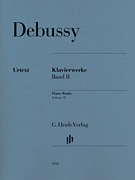
-
Debussy, Claude
Piano Works, v.2 (Heinemann/Theopold/Schilde)
Category: Piano Composer Folios
Item: 090311
Grade:
Price: $79.95
Availability: Ships in 6 to 9 Days - View Shopping Cart
-

-
Debussy, Claude
Piano Works, v.3 (Heinemann/Theopold/Schilde)
Category: Piano Composer Folios
Item: 090312
Grade:
Price: $72.95
Availability: Ships in 6 to 9 Days - View Shopping Cart
-
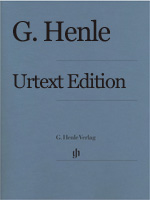
-
Debussy, Claude
Pour Le Piano (Heinemann/Lesure/Theopold)
G. Henle URTEXT edition. The first of Debussy's larger piano works was published in 1901. The slow middle movement had already been written in 1894. This grave Sarabande in the old style was published in a newspaper supplement in 1896 in its first version (regarding this early version see HN 846, Images 1894) and was slightly revised for Pour le piano. The Sarabande soon became popular and was later orchestrated by Ravel. The first movement, Prelude, evokes Javan music with ringing gongs; and the...
Read More
Category: Piano Solos
Item: 013887
Grade:
Price: $14.95
Availability: Ships in 6 to 9 Days - View Shopping Cart
-
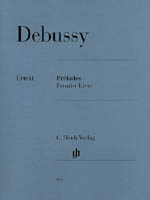
-
Debussy, Claude
Preludes, v.1 (Heinemann)
G. Henle URTEXT edition. Contents: • Les sons et les parfums • Ce qu'- vu le vent d'ouest • Danseuses de Delphes • Des pas sur la neige • La cathsdrale engloutie • La danse de Puck • La fille aux cheveux de lin • La ssrsnade interrompue • Le vent dans la plaine • Les collines d'Anacapri • Minstrels • Voiles (sample page) After several singl...
Read More
Category: Piano Composer Folios
Item: 003617
Grade:
Price: $31.95
Availability: Ships in 6 to 9 Days - View Shopping Cart
-
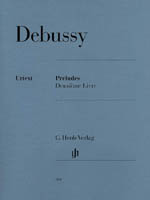
-
Debussy, Claude
Preludes, v.2 (Heinemann)
G. Henle URTEXT edition. In 1913, three years after publication of the Pr‚ludes I, another collection of twelve Pr‚ludes appeared. The pieces are longer and make use of a very wide register, which is why Debussy mainly notated them on three staves. As with the first volume of Pr‚ludes the programmatic additions only appeared at the end of each piece. The cycle closes with the virtuosic and brilliant Feux d'artifice, fireworks of pianistic bravura in the true sense of the word. The piano writing a...
Read More
Category: Piano Composer Folios
Item: 003618
Grade:
Price: $34.95
Availability: Ships in 6 to 9 Days - View Shopping Cart
-

-
Debussy, Claude
Suite Bergamasque
G. Henle URTEXT edition. Includes Prelude; Minuet; Clair de Lune; Passepied.
Category: Piano Solos
Item: 003904
Grade:
Price: $14.95
Availability: Ships in 6 to 9 Days - View Shopping Cart
-

-
Debussy, Claude
Valse Romantique (Heinemann/Theopold)
In his youth, when still searching for his own personal style, Debussy composed a series of short, stand-alone piano pieces. He took traditional genres such as the ballade, mazurka, nocturne and waltz, but in general used each of them just once, as if trying them out. One such was the "Valse romantique", published by Choudens of Paris in 1891 and thus written at the same time as his famous piano works "Two Arabesques" and the "Suite bergamasque". This charming waltz is of moderate difficulty and...
Read More
Category: Piano Solos
Item: 119733
Grade:
Price: $5.95
Availability: Ships in 10 to 15 Days - View Shopping Cart
-

-
Dvorak, Antonin
Humoreske in Gb, op 101, no 7 (Schaper/Scheideler/Leuschner)
Romantic. Many a pianist will be surprised to learn that Dvor k's famous Humoresque No. 7 was originally a piano piece, since this irresistible melody - undoubtedly one of Dvor k's happiest inspirations - has circulated throughout the musical world in innumerable arrangements for every conceivable combination. The composer himself, however, wrote only this piano solo version. The complete cycle of eight Humoresques is available in another Henle Urtext edition (HN 1044), while this "lollipop" of t...
Read More
Category: Piano Solos
Item: 119521
Grade:
Price: $5.95
Availability: Ships in 10 to 15 Days - View Shopping Cart
-

-
Dvorak, Antonin
Humoreskes, op 101 (Schaper/Scheideler/Leuschner)
Romantic. In the summer of 1894, Antonin Dvorak interrupted his stay in America in order to spend his holidays back in his homeland of Bohemia. During those happy weeks, he wrote his eight Humoresques for piano. But this music is not by no means as "Bohemian" as one might suppose. We know that Dvor k had already sketched some of the material for these pieces in New York, and there are also indications that the composer initially considered writing a series of Scottish dances. In other words, thes...
Read More
Category: Piano Solos
Item: 119809
Grade:
Price: $10.00
Availability: Ships in 10 to 15 Days - View Shopping Cart
-

-
Dvorak, Antonin
Poetic Mood Pictures, op 85
G. Henle URTEXT edition.
Category: Piano Composer Folios
Item: 008704
Grade:
Price: $29.95
Availability: Ships in 6 to 9 Days - View Shopping Cart
-

-
Dvorak, Antonin
Sonatina No 6 in G
G. Henle URTEXT edition.
Category: Piano Solos
Item: 009248
Grade:
Price: $10.95
Availability: Ships in 6 to 9 Days - View Shopping Cart
-
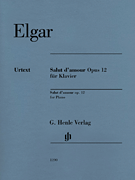
-
Elgar, Edward
Salut d'Amour, op 12 (Marshall-Luck)
Elgar might have rewritten the original for violin and piano to a version for piano solo for his fiancee and later wife. Henle has evaluated Elgar's autograph engraver's copy for the first time. -the publisher
Category: Piano Solos
Item: 103770
Grade:
Price: $10.95
Availability: Usually Ships in 24 Hours - View Shopping Cart
-

-
Faure, Gabriel
Nocturne No 6 in Db, op 63 (Loy/Koenen)
Faure's 13 Nocturnes form the most significant group of piano character pieces in his oeuvre. Despite their title - which places them in the tradition of John Field and Frederic Chopin Faur‚ here develops a genre all of his own. These are no dreamy scenes of the night, but carefully structured, iridescent pieces that alternate between lyrical elegance and passionate drama. Faure composed the 6th Nocturne in 1894, while spending the summer at the house of his parents-in-law. With its strong contra...
Read More
Category: Piano Solos
Item: 119806
Grade:
Price: $9.50
Availability: Ships in 10 to 15 Days - View Shopping Cart
-

-
Faure, Gabriel
Theme & Variations, op 73 (Jost & Schilde)
Edited by Peter Jost, fingered by Klaus Schilde.
Category: Piano Solos
Item: 049342
Grade:
Price: $18.95
Availability: Ships in 6 to 9 Days - View Shopping Cart
-

-
Field, John
Sonatas
G. Henle URTEXT edition.
Category: Piano Composer Folios
Item: 009543
Grade:
Price: $35.95
Availability: Usually Ships in 24 Hours - View Shopping Cart
-

-
Franck, Cesar
Prelude, Aria et Final
G. Henle URTEXT edition.
Category: Piano Solos
Item: 009810
Grade:
Price: $10.95
Availability: Ships in 6 to 9 Days - View Shopping Cart
-

-
Franck, Cesar
Prelude, Chorale & Fugue
G. Henle URTEXT edition.
Category: Piano Solos
Item: 009803
Grade:
Price: $17.95
Availability: Ships in 6 to 9 Days - View Shopping Cart
-
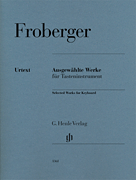
-
Froberger, Johann
Selected Works (Wollny)
Baroque. To celebrate Froberger's 400th birthday in 2016, Henle Verlag is presenting an attractive, handy volume containing four works from his pen. A toccata, a fantasia, and a canzona invite us on a musical journey of discovery into his early-Baroque musical world. The volume concludes with his well-known variations "auff die Mayerin," a work that has enabled Froberger's music to succeed in enthusing pianists as well as harpsichordists of our time. Edited by Froberger expert Peter Wollny, this ...
Read More
Category: Piano Solos
Item: 114368
Grade:
Price: $12.95
Availability: Ships in 10 to 15 Days - View Shopping Cart
-

-
Froberger, Johann
Suites for Harpsichord (Dirksen)
Froberger may no longer be considered the progenitor of the piano suite, but his suites for keyboard instruments have, without a doubt, had a considerable influence on the development of this genre. His programmatic suites, of which some bear autobiographic features, attained particular fame. Others are marked "Lamentation" or "M‚ditation" in view of his own imminent death. For the first time, all his suites are now being published in one volume as the Urtext - an unparalleled compendium of Frobe...
Read More
Category: Piano Solos
Item: 138143
Grade: Advanced
Price: $39.95
Availability: Usually Ships in 24 Hours - View Shopping Cart
-

-
Gade, Neils
Selected Works
G. Henle URTEXT edition.
Category: Piano Composer Folios
Item: 009542
Grade:
Price: $23.95
Availability: Usually Ships in 24 Hours - View Shopping Cart
-

-
Gershwin, George
Preludes for Piano (Gertsch/Boyde)
"Some of Gershwin's finest inspirations have not as yet been either published or publicly performed. It is probable that the production of his twenty-four preludes ... will award him a still higher rank in the army of contemporary composers." In 1925, anadmirer thus heralded George Gershwin's ambitious project in Vanity Fair, namely to compose preludes in all keys as Bach and Chopin had done before. On 4 December of the following year, the composer publicly performed five of these pieces. However...
Read More
Category: Piano Solos
Item: 135193
Grade: Advanced
Price: $10.95
Availability: Ships in 10 to 15 Days - View Shopping Cart
-
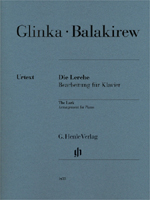
-
Glinka, Mikhail
Lerche, Die [The Lark] (Balakirev)
"The Lark" is one of the most popular Russian songs of the Romantic era, composed by the founder of the Russian nationalist school, Mikhail Glinka. His fellow countryman, Mili Balakirev, took this simple, melancholy air as the basis for a highly virtuosic piano transcription a la Liszt. It is an impressive bravura piece of moderate length that is ideally suited as an encore or in recitals. While researching this new Urtext edition, G. Henle Publishers succeeded in unearthing two sensational sour...
Read More
Category: Piano Solos
Item: 132910
Grade:
Price: $8.95
Availability: Ships in 10 to 15 Days - View Shopping Cart
-
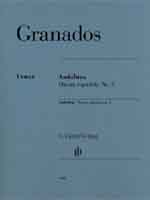
-
Granados, Enrique
Andaluza - Spanish Dance No 5, from op 37 (Scheideler/Koenen)
Among his early piano works, the twelve Danzas espa¤olas published between 1890-95 are a milestone in this Spanish composer's development. They are in the tradition of the character pieces of Chopin or Schumann, but at the same time exhibit an intense, individual coloration, as they borrow from dances from throughout Spain. This is also true of the fifth dance, which rapidly gained popularity with its catchy, somewhat nostalgic melody. Unlike any other piece "Andaluza" typifies our notions of the...
Read More
Category: Piano Solos
Item: 130908
Grade:
Price: $7.95
Availability: Usually Ships in 24 Hours - View Shopping Cart
-
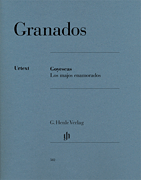
-
Granados, Enrique
Goyescas - Los Majos Enamorados (Scheideler)
20th Century (1911). The Spanish composer Enrique Granados left a varied and wide-ranging oeuvre, but it is above all his piano music that is still very much alive today. Henle's Urtext edition of the dazzlingly virtuoso Goyescas - no doubt his best-known piano composition - now brings a prestigious new work to their catalog. The suite was written between 1909 and 1911. Its unusual title goes back to the Spanish artist Francisco de Goya, whose paintings inspired Granados. The Goyescas conjure up ...
Read More
Category: Piano Solos
Item: 106550
Grade:
Price: $34.95
Availability: Ships in 6 to 9 Days - View Shopping Cart
-

-
Granados, Enrique
Quejas o la Maja y el Ruisenor [no 4 from Goyescas] (Scheideler)
This "Lament, or the Maiden and the Nightingale" is the fourth movement of Granados' six-part piano cycle Goyescas (1909-11). The cycle's title is derived from the name of the Spanish painter Francisco de Goya, whose paintings inspired Granados. The Goyescas conjure up Goya's Spain of the late 18th century - chivalrous and sensual, but also melancholic and sombre. The overall theme is the life of two young lovers. The "Quejas" are a turning point in the cycle, because here jealousy leads to a lam...
Read More
Category: Piano Solos
Item: 120255
Grade:
Price: $8.95
Availability: Ships in 10 to 15 Days - View Shopping Cart
-
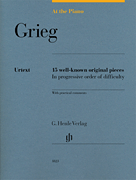
-
Grieg, Edvard
At the Piano (Hewig-Troescher)
15 Well-Known Original Pieces in Progressive Order of Difficulty. Contents: • Bell Ringing from Lyric Pieces, Op. 54, No. 6 • Watchman's Song from Lyric Pieces, Op. 12, No. 3 • Waltz from Lyric Pieces, Op. 12, No. 2 • Arietta from Lyric Pieces, Op. 12, No. 1 • Berceuse from Lyric Pieces, Op. 38, No. 1 • Remembrances from Lyric Pieces, Op. 71, No. 7 • Puck from Lyric Pieces, Op. 71, No. 3 • Litt...
Read More
Category: Piano Composer Folios
Item: 115427
Grade:
Price: $24.95
Availability: Usually Ships in 24 Hours - View Shopping Cart
-

-
Grieg, Edvard
Ballade, op 24
G. Henle URTEXT edition.
Category: Piano Solos
Item: 015716
Grade:
Price: $18.95
Availability: Ships in 6 to 9 Days - View Shopping Cart
-

-
Grieg, Edvard
Holberg Suite, op 40
G. Henle URTEXT edition.
Category: Piano Solos
Item: 013896
Grade:
Price: $15.95
Availability: Ships in 6 to 9 Days - View Shopping Cart
-
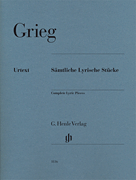
-
Grieg, Edvard
Lyric Pieces, Complete (Heinemann/Nokleberg)
Romantic. With his "Lyric Pieces", Edvard Grieg was writing a kind of poetic piano diary: between 1867 and 1901 he composed 66 short character pieces, published in ten books. Pieces such as "Wedding Day at Troldhaugen", "March of the dwarfs" or "To the spring" are among Grieg's best-known works. Alongside these fairly virtuosic pieces there are also numerous simpler dances and melodies that can be played at an early stage when learning the piano. Until now only five single books were available fr...
Read More
Category: Piano Composer Folios
Item: 110520
Grade: Advanced
Price: $53.95
Availability: Ships in 10 to 15 Days - View Shopping Cart
-

-
Grieg, Edvard
Lyric Pieces, v.1, op 12
G. Henle URTEXT edition.
Category: Piano Composer Folios
Item: 025149
Grade:
Price: $11.95
Availability: Ships in 6 to 9 Days - View Shopping Cart
-

-
Grieg, Edvard
Lyric Pieces, v.2, op 38
G. Henle URTEXT edition.
Category: Piano Solos
Item: 028892
Grade:
Price: $15.95
Availability: Ships in 6 to 9 Days - View Shopping Cart
-

-
Grieg, Edvard
Lyric Pieces, v.3, op 43
G. Henle URTEXT edition.
Category: Piano Solos
Item: 031778
Grade:
Price: $9.95
Availability: Ships in 6 to 9 Days - View Shopping Cart
-

-
Grieg, Edvard
Lyric Pieces, v.5, op 54
G. Henle URTEXT edition.
Category: Piano Composer Folios
Item: 036472
Grade:
Price: $19.95
Availability: Ships in 6 to 9 Days - View Shopping Cart
-

-
Grieg, Edvard
Lyric Pieces, v.8, op 65
G. Henle URTEXT edition.
Category: Piano Composer Folios
Item: 040455
Grade:
Price: $19.95
Availability: Ships in 6 to 9 Days - View Shopping Cart
-

-
Grieg, Edvard
Norwegian Dances, op 35 (Heinemann/Steen-Nokleberg)
Romantic. The decisive role that Norwegian folk music played for Edvard Grieg can be felt in almost all of his works. For his Norwegian Dancesop. 35, presented here in an Urtext edition, Grieg took old folk tunes from a collection published by the musician and researcher Ludvig Mathias Lindeman and arranged them for piano four hands in 1880. A few years later, Grieg also made the two-hand version presented here. For this Henle Urtext edition, all the extant autographs in the Grieg Archive in Berg...
Read More
Category: Piano Solos
Item: 119811
Grade:
Price: $13.95
Availability: Ships in 10 to 15 Days - View Shopping Cart
-

-
Grieg, Edvard
Norwegian Peasant Dances
G. Henle URTEXT edition.
Category: Piano Composer Folios
Item: 020850
Grade:
Price: $25.95
Availability: Usually Ships in 24 Hours - View Shopping Cart
-
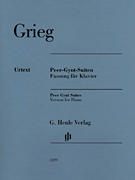
-
Grieg, Edvard
Peer Gynt Suite (Heinemann/Nokleberg)
Grieg's incidental music for Henrik Ibsen's drama "Peer Gynt" contains some of his best-known compositions, such as "Morning mood" and "In the hall of the Mountain King". Grieg later extracted the most beautiful pieces to form two orchestral suites and arranged himself these versions for piano solo and piano four-hands. There was a surprise in store for Henle when preparing their Urtext edition. In the autograph and the first print run, the second suite contained another movement, the "Dance of t...
Read More
Category: Piano Solos
Item: 112800
Grade:
Price: $16.95
Availability: Ships in 10 to 15 Days - View Shopping Cart
-

-
Grieg, Edvard
Sonata in Em, op 7
G. Henle URTEXT edition.
Category: Piano Solos
Item: 009805
Grade:
Price: $17.95
Availability: Ships in 6 to 9 Days - View Shopping Cart
-
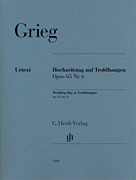
-
Grieg, Edvard
Wedding Day at Troldhaugen, op 65, no 6 (Heinemann/Nokleberg)
Romantic. With his 66 Lyric Pieces, Edvard Grieg created a multifacted treasury of piano miniatures and character pieces. Many have become piano classics, none more so than The Wedding at Troldhaugen, which Henle publishers offers here in a separate edition. In this boisterous piece Grieg recalls a glittering celebration at the Villa Troldhaugen on the occasion of his silver wedding, something which attracted hundreds of guests and well-wishers. The fingerings by Norwegian Grieg specialist Einar ...
Read More
Category: Piano Solos
Item: 112619
Grade:
Price: $6.95
Availability: Ships in 10 to 15 Days - View Shopping Cart
-

-
Handel, Georg Frederic
Air (Harmonious Blacksmith)
G. Henle URTEXT edition.
Category: Piano Solos
Item: 013880
Grade:
Price: $8.95
Availability: Ships in 6 to 9 Days - View Shopping Cart
-

-
Handel, Georg Frederic
Fugues (8), HWV 605-612 (Scheideler & Schneidt)
Handel and fugues? The connection is not the first thing to cross our minds when we think of baroque keyboard music. Yet Handel, besides writing keyboard fugues as parts of larger works, also turned out separate fugues beginning from his days in Hamburg.Our edition combines the well-known Six Fugues (HWV 605-610) with two isolated fugues (HWV 611 and 612). Handel later reused some of these fugues in his concerti grossi, the oratorio "Israel in Egypt", and in a trio sonata, where they have become ...
Read More
Category: Piano Composer Folios
Item: 052080
Grade:
Price: $21.95
Availability: Ships in 6 to 9 Days - View Shopping Cart
-

-
Handel, Georg Frederic
Suites & Pieces (London, 1733)
G. Henle URTEXT edition.
Category: Piano Composer Folios
Item: 031604
Grade:
Price: $45.95
Availability: Ships in 6 to 9 Days - View Shopping Cart
-

-
Handel, Georg Frederic
Suites (8) (Hicks/Theopold)
G. Henle URTEXT edition. London Suites (1720). Includes 8 Suites, HWV 426-433, plus an appendix of early versions of single movements.
Category: Piano Composer Folios
Item: 013867
Grade:
Price: $38.95
Availability: Ships in 6 to 9 Days - View Shopping Cart
-

-
Haydn, Franz Joseph
Dances & Marches
G. Henle URTEXT edition.
Category: Piano Solos
Item: 025148
Grade:
Price: $19.95
Availability: Ships in 6 to 9 Days - View Shopping Cart
-
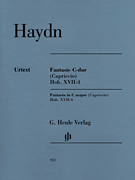
-
Haydn, Franz Joseph
Fantasia in C (Capriccio), Hob.XVII:4 (Gerlach/Schornstein)
Classical. When he switched from the harpsichord to the fortepiano in the 1780s, Joseph Haydn found he had a rich palette of sound colors and dynamic variations at his disposal, and he employed them enthusiastically in his C-major Fantasy. This piano piece, composed in early 1789 in a "whimsical hour," was intended by Haydn to meet with approval from "both connoisseurs and amateurs" - not least because it is "not too difficult." Christine Schornsheim provides historically accurate fingerings. Thi...
Read More
Category: Piano Solos
Item: 114422
Grade:
Price: $11.95
Availability: Usually Ships in 24 Hours - View Shopping Cart
-
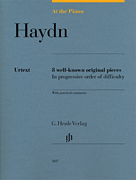
-
Haydn, Franz Joseph
Haydn: At the Piano (Hewig-Troescher)
Category: Piano Composer Folios
Item: 115362
Grade:
Price: $19.95
Availability: Ships in 10 to 15 Days - View Shopping Cart
-

-
Haydn, Franz Joseph
Little Early Sonatas (9)
G. Henle URTEXT edition.
Category: Piano Composer Folios
Item: 032506
Grade:
Price: $18.95
Availability: Ships in 6 to 9 Days - View Shopping Cart
-

-
Haydn, Franz Joseph
Piano Pieces & Variations (Gerlach/Theopold)
G. Henle URTEXT edition
Category: Piano Composer Folios
Item: 013834
Grade:
Price: $24.95
Availability: Ships in 6 to 9 Days - View Shopping Cart
-

-
Haydn, Franz Joseph
Selected Sonatas, v.1
G. Henle URTEXT edition
Category: Piano Composer Folios
Item: 012629
Grade:
Price: $39.95
Availability: Ships in 6 to 9 Days - View Shopping Cart
-

-
Haydn, Franz Joseph
Selected Sonatas, v.2
G. Henle URTEXT edition
Category: Piano Composer Folios
Item: 003348
Grade:
Price: $39.95
Availability: Ships in 6 to 9 Days - View Shopping Cart
- p.1 (Al - Ba)
- p.2 (Ba - Ba)
- p.3 (Ba - Be)
- p.4 (Be - Br)
- p.5 (Br - Ch)
- p.6 (Ch - De)
- p.7 (De - Ha)
- p.8 (Ha - Li)
- p.9 (Li - Mo)
- p.10 (Mo - Sa)
- p.11 (Sa - Sc)
- p.12 (Sc - Sc)
- p.13 (Sc - We)
- Next >
More Options
- Use our Custom Order Page to special order items you can't find.
- Use our Catalog Order Page to order items from a printed catalog, or if you already know our catalog number for the item(s) you're interested in.
- And as always, feel free to E-mail us with your questions!
